Telescope to See the Moon: Type, Use, Conditions
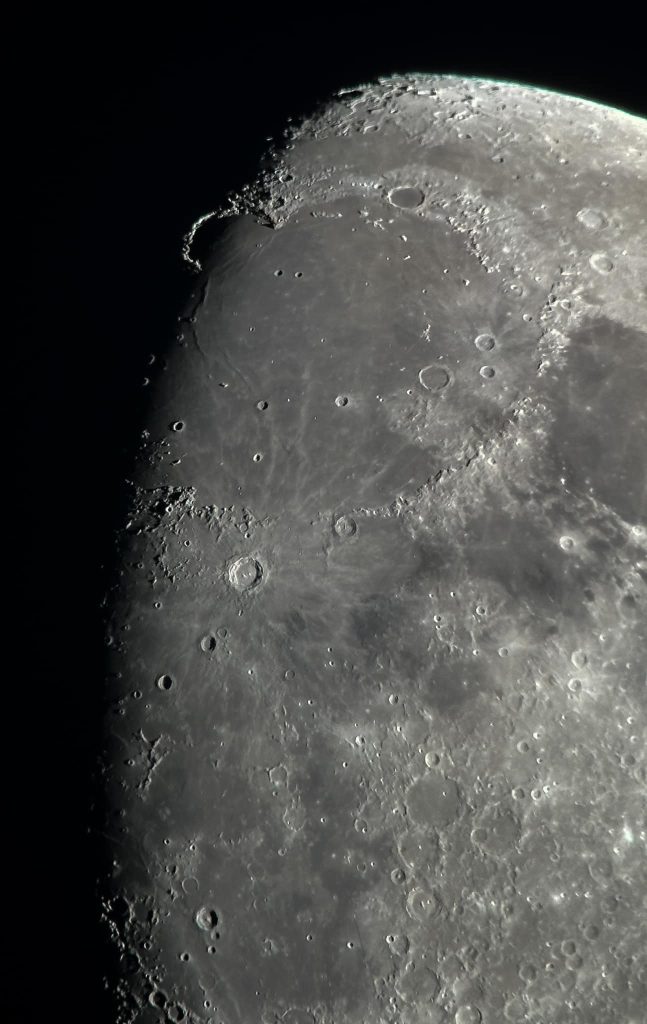
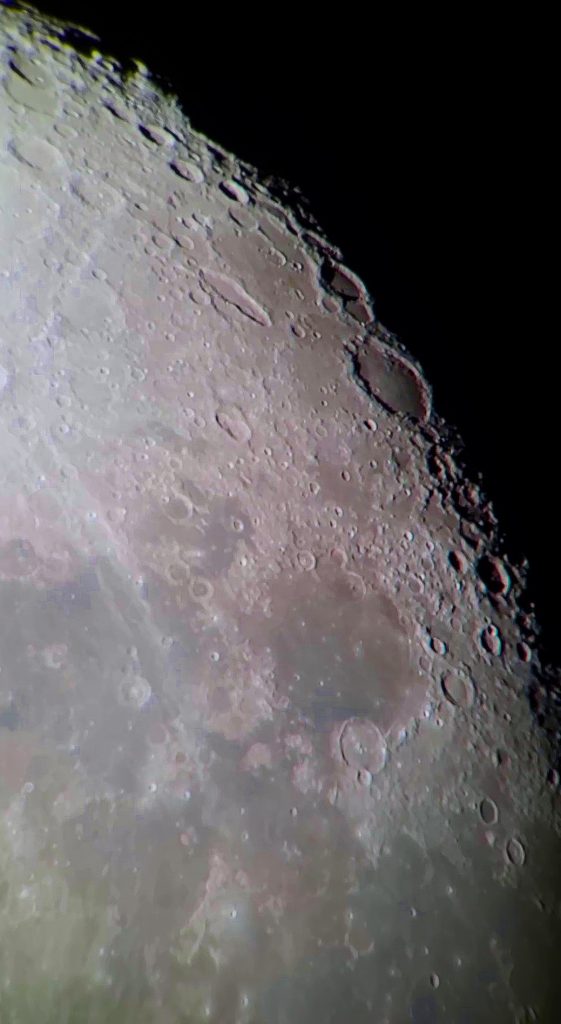
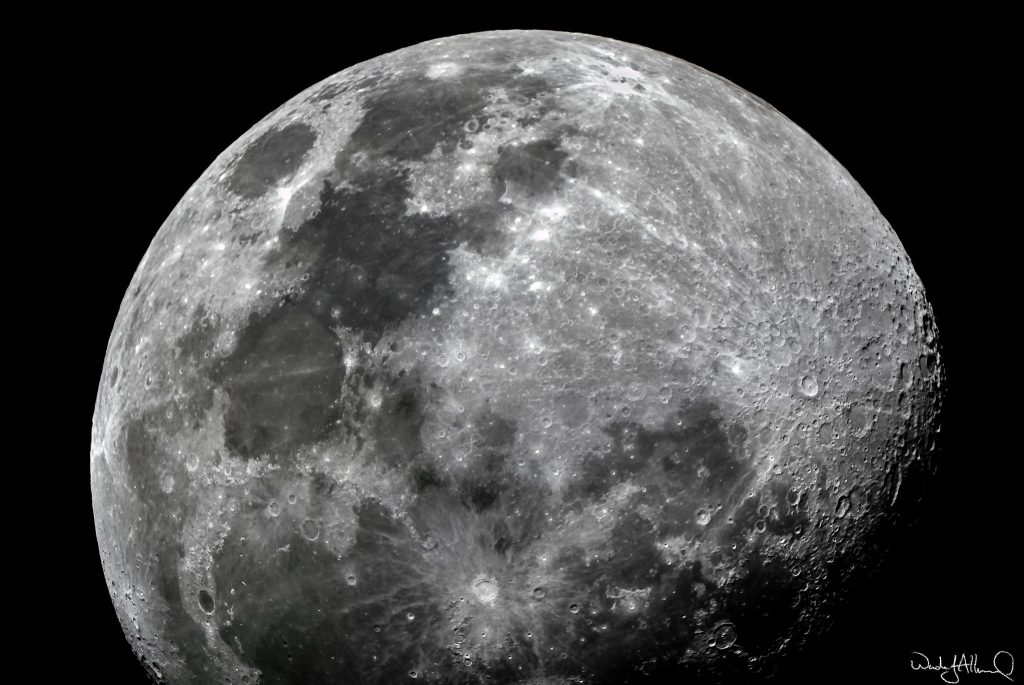
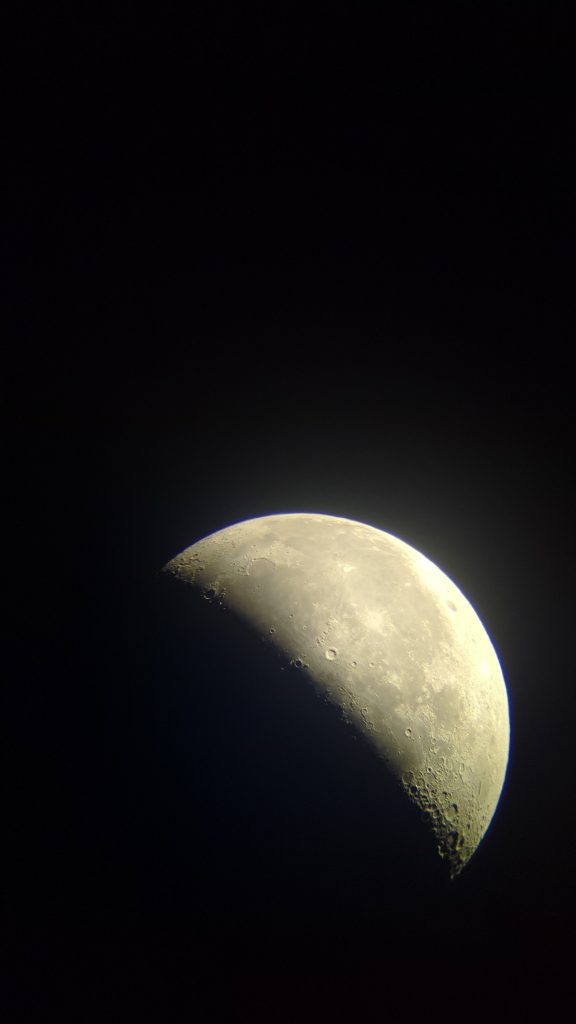
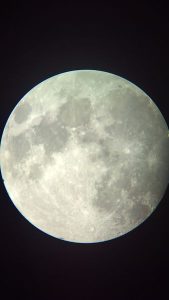
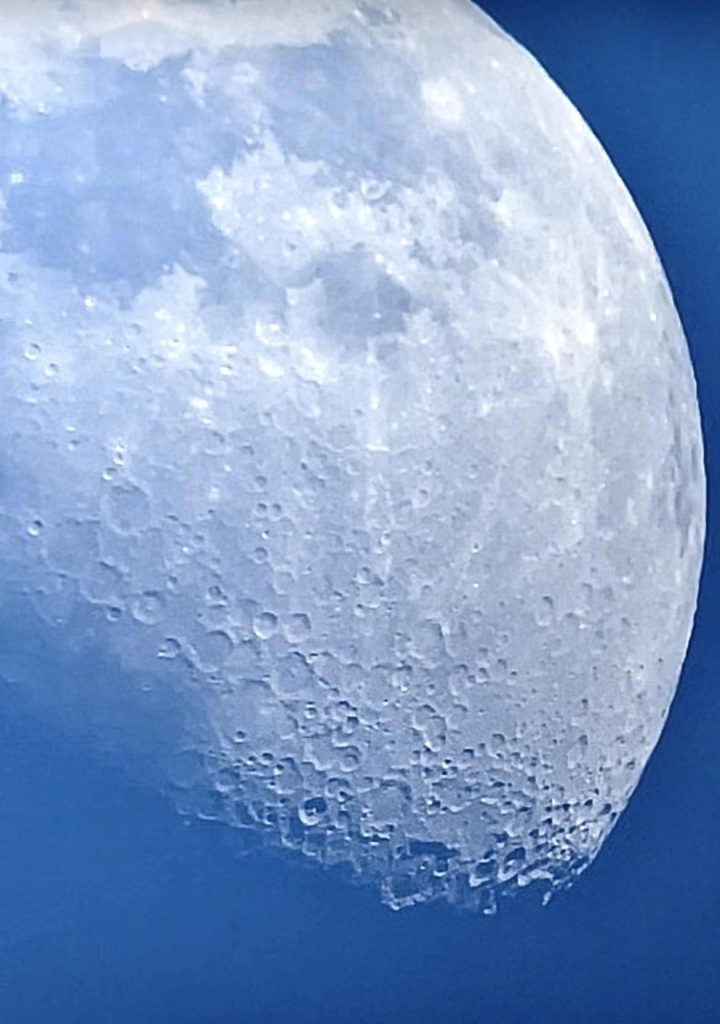
Telescopes with decent optics paired with a clear sky allow one to see the Moon. Low quality telescopes are capable of showing details of the Moon. The best telescope to see the Moon is a refractor telescope with an apochromatic lens. A model offering a lens diameter (aperture) of at least 60 mm and at most 100 mm allows clear viewing. Pairing with a focal length between 700 mm and 1000 mm balances sharp contrast with comfortable magnification.
When the Moon is a couple of days out from the full Moon, or between a thin crescent and a waxing gibbous, shadows outline craters and ridges, giving the richest detail.
Observing when the Moon is high in the sky delivers steady air and the brightest, clearest image.
What kind of telescope can be used to see the Moon?
The best type of telescope to use for observing the moon clearly is a refractor telescope equipped with an apochromatic lens, such a refractor telescope with an apochromatic lens provides high-contrast, sharp images. Beginner telescopes with 4- or 5-inch (10.16- or 12.7 cm) apertures are great for viewing the Moon, and even a small, entry-level 60 mm (2.36 in) telescope at 70 will provide breathtaking views. Any telescope with decent optics and a sturdy mount will do, for any telescope can show the largest craters on the Moon, binoculars can also show the largest craters on the Moon, but a lens diameter of at least 60 mm (2.36 in) to 100 mm (3.94 in) is recommended for more detailed views. Aperture of at least 60 mm (2.36 inches) provides detailed views of the Moon, and getting a quality telescope with an aperture of at least 8 inches (203.2 mm) will be your best option if you want to move beyond beginner equipment.
No Earth-based telescope, however large, can resolve the Apollo flag, NASA’s Lunar Reconnaissance Orbiter can just make out the flag left by Apollo 17 astronauts because it can resolve objects about 1 meter (3.28 feet) across, but from Earth the angular size of the flag is far below the limit of any amateur instrument. Therefore, to enjoy crisp craters, ridges, and terminator shadows, choose a 4-5-inch refractor or reflector, mount it firmly, and use medium focal length eyepieces for the full lunar disc or short focal length eyepieces for close-ups.

Which telescope is best to see the surface of the Moon?
NexStar 130SLT offers an ideal combination of aperture, focal length, optics and camera compatibility, making it a top choice for capturing detailed images of the Moon’s surface. An aperture of 60 mm (2.36 in) to 100 mm (3.94 in) is recommended for detailed views, while a focal length between 700 mm (27.56 in) and 1000 mm (39.37 in) frames the lunar disk crisply. Optics on the Astro Fi 130 provide enough magnification to reveal craters and rilles, so a smaller telescope can satisfy the user’s needs when optics are high quality.
For observers who want to splurge, Celestron NexStar 8SE is best, and Schmidt-Cassegrain telescopes supply crisp, high-magnification optics. Sky Watcher Flextube 300 Dobsonian offers a 305 mm (12 in) aperture, 1500 mm (59.06 in) focal length and excellent views of the lunar surface, whereas Sky Watcher Skymax 180 Pro gives exceptional views with its 180 mm (7.09 in) aperture perfect for bright, contrasty images. Refractor telescopes deliver clear, high-contrast images with low distortion, and a simple adapter works best for bright objects like the Moon.
Tycho and its rays are best seen during full Moon with a telescope, while earthshine faintly illuminates the night side, revealing additional surface markings. The ZWO ASI290MM Mini captures short video files of the Moon’s surface using a high frame rate, and Unistellar eVscope 2 can be operated by anyone with the compatible smartphone app to take amazing astrophotographs.
How close can you see the Moon with a telescope?
On perfect nights a great telescope spots features as small as a kilometer (0.62 miles) on the lunar surface, an amateur telescope resolves features 600-700 metres (1,968.5-2,296.6 feet) across, while a 1-metre (3.28 feet) telescope with 0.1-arcsecond resolving power reveals detail size of 186 m (610.2 feet).
With a telescope no greater than 4 (101.6 mm) in aperture you observe all of the Moon’s major craters and mountain chains, a 60 mm (2.36 inches) telescope at 70 provides breathtaking views, and you go quite close to the Moon without any harm to the telescope.
Why can’t we see the Moon landing site with a telescope from Earth? Because the resolving power of a standard ground-based telescope is limited to around 1-2 arcseconds by atmospheric seeing, we need a telescope at least 75 feet (25 metres) across to spot a 32-foot (10-metre) object on the Moon, far larger than any amateur instrument. In fact no Earth-based telescope could resolve the 4.2-metre-wide (13.8 feet) Apollo lunar landers or the flag left by Apollo 17, even the 8.2 m (26.9 feet) Very Large Telescope at Paranal has only resolved features as small as 130 m (426.5 feet) across, which is not good enough to distinguish the landers, the buggy, or the short shadows they cast.
A telescope sees a person on the Moon with 0% chance. From Earth, an astronaut appears as a tiny white dot 1.6 m (5.25 ft) high, but the required resolution exceeds any existing ground telescope, 1.6 m (5.25 ft) is only just large enough to be seen from a distance of about 165 km (102.5 mi), far closer than the average 384,000 km (238,607 mi) to the Moon.
Can you see the retro-reflectors on the Moon with a telescope? You cannot see the retro-reflectors themselves, but you can bounce laser pulses off them, astronauts placed retro-reflectors on the Moon during Apollo missions and they still work today, enabling lunar laser ranging that measures the distance to the Moon with millimetre precision.
Can you see rover tracks on the Moon with a telescope? Earth-based telescopes cannot resolve the 30 cm-wide (11.8 in-wide) rover tracks, instead, the Lunar Reconnaissance Orbiter (LRO) spacecraft, orbiting much closer to the Moon, returned images that show Apollo descent stages, equipment, walking trails, boot prints and rover tire tracks at all six Apollo landing sites.
How to see the Moon from a telescope?
To see Moon from telescope follow the steps explained below.
- Keep tools like telescope ready for Moon watching
- Gather crowds by pointing telescope toward Moon
- Aim it toward the moon
- Observe Moon comfortably from home
- Look at Moon when it is between thin crescent and waxing gibbous
- Point it toward the moon
- View Moon a few days after first quarter for best results
- Avoid using too high magnification for clearer view
Begin by taking the telescope outside when the Moon is high in the sky, the Moon is big, bright, and easy to find on almost any night, so aiming is trivial even if the mount lacks a finder. After you point it toward the Moon, swap in a low-power eyepiece that frames the whole lunar disc, this eyepiece is bright, concentrated and magnified, so the light is never blank inside the telescope. Expectations for magnification are simple: start at 10 to 15 , then climb to 80 -150 for medium power, and stop near 150 unless your telescope offers one inch of aperture for every 50 you demand. A moon filter adds contrast and reduces glare, so install it whenever the disc is full or nearly full, the filter will cut the light and prevent hopeless dazzle without any need to stop down the telescope. For the steadiest views, mount the instrument on a lightweight photographic tripod, or, if you prefer binoculars, attach a 15 or 20 model to the same support. The absolute best time to observe is a few days after first quarter, when the Moon is between a thin crescent and a waxing gibbous, because long shadows then reveal more surface features. Finally, you can reinforce what you see by opening NASA’s interactive Moon map or the SkyPortal app, these tools label the 100 lunar features listed in the RASC Observer’s Handbook and let you confirm that we only ever see one side of the Moon from Earth.
I prefer to utilize low-power eyepiece at first, then boost magnification consistently while I investigate particular areas. Pleasing views appear along terminator line, where light reveals extent of depressions and composition of elevation extents, terminator line gives spectacular distinction between bright and dark. I let my eyes adapt to shadow for about 20 seconds. Immediate overhead sunshine renders surface featureless, cancels shadowiness, and renders cover even, so I refrain from observation then. When atmosphere is tumultuous, agitated air makes picture shimmer and lose detail, therefore I refrain from superior powers.
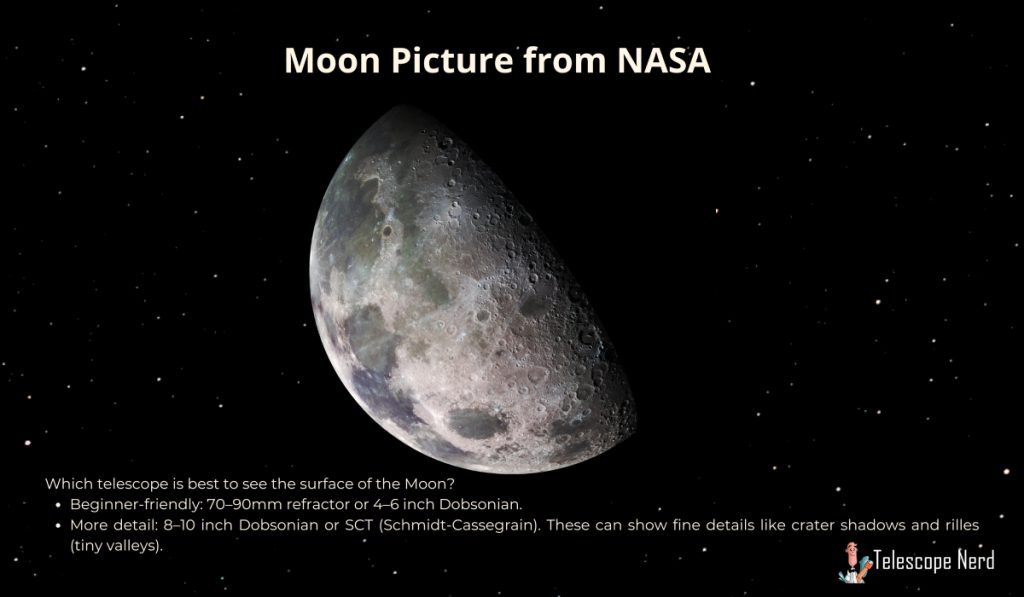
Why can’t I see the Moon through my telescope?
Start by checking the finderscope, it must be properly aligned or the Moon will sit outside the main field even when it is centred in the finder. Once alignment is confirmed, look at the eyepiece choice: too high magnification amplifies every tremor and, because atmospheric seeing limits maximum magnification, the image turns into a boiling blur. A shaky, wobbly mount won’t show anything at high magnification, so keep the power low until the air steadies and the mount is locked tight.
Brightness is the next hurdle. The Moon is bright enough to wash out anything else of interest in the sky, and its flat appearance through the telescope is caused by the small angular size combined with overwhelming glare. A Moon filter reduces the brightness and simultaneously adds contrast, without it, subtle rays and rilles vanish in the glare. Shadows create contrast, making lunar features more visible, so try a session when the terminator is in view instead of during a full Moon-the full phase is the worst time for us to observe it because the face-on sunlight erases shadow detail.
Finally, examine the optical quality. Poor telescope optics scatter incoming light and smear fine details into a hazy glow, while thermals inside the telescope tube warp the image unless the instrument has cooled to night air. Let the scope equalise for thirty minutes, keep magnification modest, insert the Moon filter, and the same bright disc that once looked blank will suddenly be covered with amazing detail.

Can you see the Moon through a telescope during the day?
Moon is seen during the day because it’s large enough and close enough to the Earth, scattered daylight doesn’t completely wash it out. Moon can be observed during the day with a telescope, yet the telescope will not be as effective as at night. Atmospheric turbulence during the daytime doesn’t allow a larger telescope to fully utilize its resolving power, so images remain slightly softer. Observing Moon at daytime is safe as long as you don’t point telescope close to Sun, keep the Sun hidden behind a large building or use a daylight filter mounted on any telescope. You see the Moon in the afternoon if it is waxing, and you see the Moon in the morning if it is waning. Moon is not seen during the day during New Moon phase, because the Sun-lit side faces away from Earth. Moon is not seen during the day during Full Moon phase, because it sets as Sun rises and rises as Sun sets. Therefore, Moon is seen during the day during other phases, appearing pale and ghostly against the blue sky.
Blood Moon is a total lunar eclipse, the Moon appears red during a total lunar eclipse. Lunar eclipse is visible with the naked eye, and no special eclipse glasses are needed because looking at the full Moon does not damage the eye. Binoculars will enhance view of lunar eclipse, yet the event is already bright enough to watch without equipment.
Pink Moon is the first full Moon of spring, April’s full Moon is called the pink Moon. Pink Moon is visible without a telescope, as it is simply a full Moon with a traditional name, not a color change.
